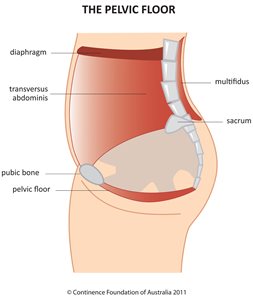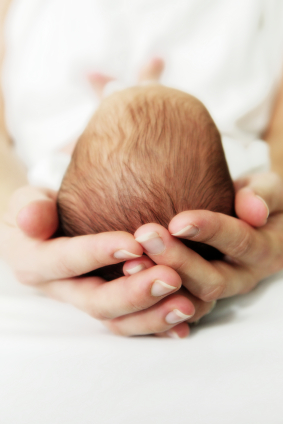What are the Pelvic Floor Muscles and what do they do

The pelvic floor muscles are a layer of muscles that stretch from the pubic bone at the front to the coccyx (tailbone) at the back. It is structured like a muscular trampoline. The pelvic floor muscles are frequently overlooked, even though they are one of the most important muscle groups in the body, contributing significantly to sexual response, guiding the baby’s head down the birth canal during child birth and providing support to the bladder, uterus and bowel. A strong and well working pelvic floor helps you hold on to a full bladder. It also helps you to hold on to wind when you want to. Your pelvic floor muscles tighten to prevent the leakage of urine when you cough, sneeze, laugh and move. Can you imagine what would happen if these muscles didn’t work properly?
Where are my Pelvic Floor muscles?
Here’s a helpful exercise to help you understand and realise the small size of this muscle group:
-
Just put your hands under your bottom on each side, palms up and sit with your fingers under your sitting bones. The pelvic floor muscle spans this space (side to side).
-
Now find the pubic bone at the front and coccyx (tailbone) at the tip of the spine – this is the distance which the pelvic floor muscles span (front to back).
How to identify your Pelvic Floor muscles
One way to help you to identify the pelvic floor muscles is to stop or slow the flow of urine midway through emptying the bladder. This is NOT recommended as a regular exercise.
Our booklet, As Your Shape Changes, will help you to become more aware of your muscles, enable you to check that you are doing the exercises correctly and help you know when to seek the advice and assistance of your Physiotherapist or Fitness Instructor.
Many people are unaware of how to correctly exercise the pelvic floor muscles. To learn how to find and identify your muscles correctly read the instructions that we helped to write when working on The Pelvic Floor First campaign.
What can affect my pelvic floor muscles? 
The pelvic floor muscles are frequently weakened by pregnancy and childbirth and they require special attention during this time. Pelvic floor muscle weakness can result from:
• lack of use
• the weight of the baby on the muscles in pregnancy
• the hormonal changes of pregnancy
• stretching of the muscles during childbirth
• regularly straining to use the bowels
• pushing, or straining to finish emptying the bladder
• lots of heavy lifting
• carrying extra weight
The muscles may continue to weaken as a woman ages and experiences the hormonal changes of menopause. This means that minor problems that start after childbirth may progressively worsen with age.
Did you know ....
The Continence Foundation of Australia statistics reveal that:
• 1 in 3 women who have had children will experience some degree of poor bladder control after childbirth, or around menopause
• 64% of pregnant women experience incontinence of urine
• 47% of women may experience urine leakage during exercise, or while playing sport.
One survey of 1505 women showed that:
• At three months post partum, 34.3% admitted to some degree of urinary incontinence
• 8.5% needed to wear a pad for their incontinence.
Of those in this survey who had just had their first baby:
• 62.6% reported their incontinence began during pregnancy
• 17.6% reported it started after childbirth
• 19.4% had urine leakage before pregnancy.
Of all 1505 women surveyed:
• only 16.9% did daily pelvic floor muscle exercises during pregnancy
• only 14.9% did daily pelvic floor muscle exercises at 3 months post partum.
In another study 78.5% were unable to properly contract their pelvic floor muscles one year after having a baby. Many pregnant women incorrectly believed incontinence was a transient problem, caused by giving birth, that would correct itself.
What are the benefits of doing pelvic floor exercises in pregnancy?
• Daily pelvic floor exercises during pregnancy reduce the risk of urinary incontinence.
• Exercising the pelvic floor muscles regularly during pregnancy makes it easier to contract and tighten the muscles after childbirth.
• The stronger the pelvic floor muscles during and after pregnancy, and the better the pelvic floor muscles are working, the less the risk of stress incontinence, which is leakage of urine during a cough, sneeze, laugh, movement, lifting, sport, or exercise.
What is the role of pelvic floor exercises after childbirth?
• Starting pelvic floor exercises within the first few days after childbirth will help the muscles to recover more quickly. Even women who have had stitches can do pelvic floor exercises.
• The condition of the pelvic floor muscles during and after pregnancy affects the life long health of a woman. Studies have shown that women who are unaware of their pelvic floor muscles, or who do not exercise them, are more likely to experience problems in future life.
Does sport have any effect on the pelvic floor muscles?
• Women may incorrectly believe their sport and other high impact exercise is taking care of their pelvic floor muscles. Participating in sport, running or other high impact activities during pregnancy and early after childbirth may actually reduce pelvic floor muscle strength and cause long-term bladder and bowel problems.
These physical problems may include the risk of pelvic organ prolapse requiring surgical repair.
As Your Shape Changes contains valuable advice and a checklist that should be used to determine readiness to return to sport and high impact exercise after childbirth..
The effects of pregnancy and childbirth on your bowels
It is not often that we stop to talk about our bowel habits with other people; so, how do you know what you experience is normal? Many women have, in fact, grown up with bowel habits that are not normal. Regularly straining to use the bowels, even just a small amount, can weaken the muscles that make up your pelvic floor. The hormonal changes and stretching associated with pregnancy and childbirth also weakens these muscles.
The weakened pelvic floor muscles may not work properly when you empty your bowels. Some women with weakened pelvic floor muscles experience pain or difficulty in using the bowels, which results in straining. The effect of straining actually weakens the pelvic floor muscles even more, further increasing the need to strain. It's a vicious cycle!
Over time, the weakened pelvic floor can lead to leakage of urine (also known as incontinence) Prolapse (where your pelvic organs drop down or feel like they are falling out) is also much more common in women who strain to use their bowels. Samantha's Story gives an account of what can happen over time as a result of straining and a weakened pelvic floor.
Ideas to help you to remember to do your pelvic floor exercises.
Whether you are pregnant, planning a pregnancy or have had a baby, it is important to remember to do your pelvic floor muscle exercises and your tummy bracing exercises. This will help to keep your muscles strong if you are pregnant and help them to recover more quickly after your baby has been born. All women should do pelvic floor exercises, even once they have returned to normal after pregnancy.
Do you forget to do your exercises regularly? If so, you could place some reminder dots in places that will remind you to do the exercises. For example, on the mirror, television, phone or computer; in the toilet (for after you have finished going, not during your flow); in your wallet; where you sit to feed your baby or toddler; or anywhere else that will remind you to tighten your pelvic floor and tummy muscles. Using a screen saver, a phone reminder, a note in your diary or on your calendar can also help you to remember to do your pelvic floor muscle exercises.
Copyright 2011 - 2020. Demac Resources Pty Ltd. www.thepregnancycentre.com.au